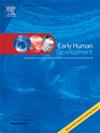危重型先天性心脏病新生儿的术前自主神经衰竭
IF 2.2
3区 医学
Q2 OBSTETRICS & GYNECOLOGY
引用次数: 0
摘要
背景:新生儿重症先天性心脏病(cCHD)经历了一个复杂的过渡到体外生活。然而,目前缺乏利用心率变异性对自主神经张力进行连续监测。材料和方法我们收集了入院时或手术前10天伴有大动脉右转(d-TGA)和左心发育不全综合征(HLHS)的新生儿的连续心电图。计算心跳间隔(RRi),并将其划分为每10分钟一次。计算RRi在每个epoch内的频谱指标,包括低频(LF)和高频(HF)功率,以及去趋势波动分析指标(αS、αL、RMSS和RMSL),并在24 h内取平均值。使用线性混合效应模型分析RRi指标与手术时间之间的关系,并调整产前和产后因素。结果本研究纳入10例HLHS患儿和23例d-TGA患儿。RRi指标的可用性为110天。在未调整的模型中,LF功率(估计:−4.4×10−3,P = 0.02)、HF功率(−4.1 x 10−2,5 x 10−5)、RMSS(−3.7 x 10−4,8.7 x 10−3)和RMSL(−1.4 x 10−3,0.02)均与手术时间呈负相关,其中HF功率的相关性最强。调整协变量后,高频功率与时间保持显著负相关(- 0.04,P = 0.03)。cCHD诊断对RRi指标无显著影响。结论新生儿cCHD患者在手术前自主神经功能逐渐下降。RRi指标可以作为这些患者生理恶化的有价值的指标。本文章由计算机程序翻译,如有差异,请以英文原文为准。
Preoperative autonomic failure in neonates with critical congenital heart disease
Background
Neonates with critical congenital heart disease (cCHD) undergo a complicated transition to ex-utero life. However, continuous monitoring of autonomic tone using heart rate variability is currently lacking.
Materials and methods
We retrieved continuous electrocardiograms from the time of admission or from 10 days prior to surgery for neonates with dextro-transposition of the great arteries (d-TGA) and hypoplastic left heart syndrome (HLHS). Beat-to-beat intervals (RRi) were calculated and divided into 10-min epochs. Spectral metrics, including low-frequency (LF) and high-frequency (HF) powers, as well as detrended fluctuation analysis metrics (, , , and ), were computed for RRi within each epoch and averaged over 24 h. The relationship between RRi metrics and time to surgery was analyzed using linear mixed-effects models, adjusting for prenatal and postnatal factors.
Results
The study included 10 neonates with HLHS and 23 with d-TGA. RRi metrics were available for 110 days. In the unadjusted models, LF power (Estimate: −4.4×, P = 0.02), HF power (−4.1 x , 5 x ), (−3.7 x , 8.7 x ), and (−1.4× , 0.02) were all negatively associated with time to surgery, with HF power showing the strongest association. After adjusting for covariates, HF power retained its significant negative association with time (−0.04, P = 0.03). The cCHD diagnosis did not significantly influence RRi metrics.
Conclusions
In neonates with cCHD, there is a progressive decline in autonomic function leading up to surgery. RRi metrics may serve as valuable indicators of deteriorating physiology in these patients.
求助全文
通过发布文献求助,成功后即可免费获取论文全文。
去求助
来源期刊

Early human development
医学-妇产科学
CiteScore
4.40
自引率
4.00%
发文量
100
审稿时长
46 days
期刊介绍:
Established as an authoritative, highly cited voice on early human development, Early Human Development provides a unique opportunity for researchers and clinicians to bridge the communication gap between disciplines. Creating a forum for the productive exchange of ideas concerning early human growth and development, the journal publishes original research and clinical papers with particular emphasis on the continuum between fetal life and the perinatal period; aspects of postnatal growth influenced by early events; and the safeguarding of the quality of human survival.
The first comprehensive and interdisciplinary journal in this area of growing importance, Early Human Development offers pertinent contributions to the following subject areas:
Fetology; perinatology; pediatrics; growth and development; obstetrics; reproduction and fertility; epidemiology; behavioural sciences; nutrition and metabolism; teratology; neurology; brain biology; developmental psychology and screening.
 求助内容:
求助内容: 应助结果提醒方式:
应助结果提醒方式:


